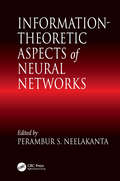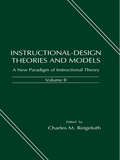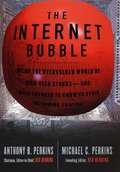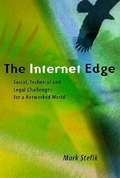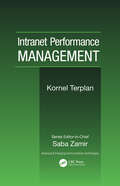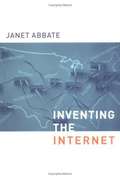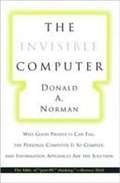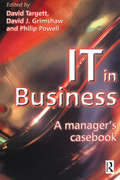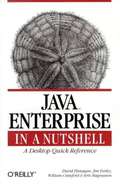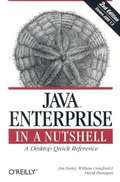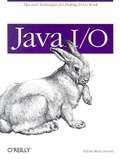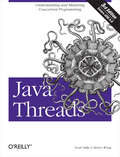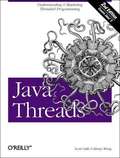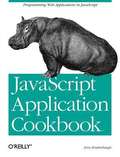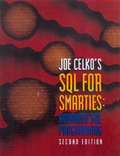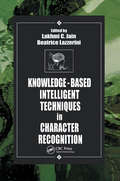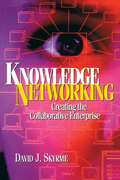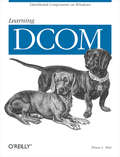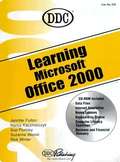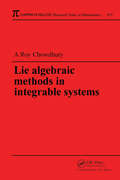- Table View
- List View
Information-Theoretic Aspects of Neural Networks
by P. S. NeelakantaInformation theoretics vis-a-vis neural networks generally embodies parametric entities and conceptual bases pertinent to memory considerations and information storage, information-theoretic based cost-functions, and neurocybernetics and self-organization. Existing studies only sparsely cover the entropy and/or cybernetic aspects of neural information.Information-Theoretic Aspects of Neural Networks cohesively explores this burgeoning discipline, covering topics such as:Shannon information and information dynamicsneural complexity as an information processing systemmemory and information storage in the interconnected neural webextremum (maximum and minimum) information entropyneural network trainingnon-conventional, statistical distance-measures for neural network optimizationssymmetric and asymmetric characteristics of information-theoretic error-metricsalgorithmic complexity based representation of neural information-theoretic parametersgenetic algorithms versus neural informationdynamics of neurocybernetics viewed in the information-theoretic planenonlinear, information-theoretic transfer function of the neural cellular unitsstatistical mechanics, neural networks, and information theorysemiotic framework of neural information processing and neural information flowfuzzy information and neural networksneural dynamics conceived through fuzzy information parametersneural information flow dynamicsinformatics of neural stochastic resonanceInformation-Theoretic Aspects of Neural Networks acts as an exceptional resource for engineers, scientists, and computer scientists working in the field of artificial neural networks as well as biologists applying the concepts of communication theory and protocols to the functioning of the brain. The information in this book explores new avenues in the field and creates a common platform for analyzing the neural complex as well as artificial neural networks.
Instructional-design Theories and Models: A New Paradigm of Instructional Theory, Volume II
by Charles M. ReigeluthInstructional theory describes a variety of methods of instruction (different ways of facilitating human learning and development) and when to use--and not use--each of those methods. It is about how to help people learn better. This volume provides a concise summary of a broad sampling of new methods of instruction currently under development, helps show the interrelationships among these diverse theories, and highlights current issues and trends in instructional design. It is a sequel to Instructional-Design Theories and Models: An Overview of Their Current Status, which provided a "snapshot in time" of the status of instructional theory in the early 1980s. Dramatic changes in the nature of instructional theory have occurred since then, partly in response to advances in knowledge about the human brain and learning theory, partly due to shifts in educational philosophies and beliefs, and partly in response to advances in information technologies. These changes have made new methods of instruction not only possible, but also necessary in order to take advantage of new instructional capabilities offered by the new technologies. These changes are so dramatic that many argue they constitute a new paradigm of instruction, which requires a new paradigm of instructional theory. In short, there is a clear need for this Volume II of Instructional Design Theories and Models. To attain the broad sampling of methods and theories it presents, and to make this book more useful for practitioners as well as graduate students interested in education and training, this volume contains twice as many chapters, but each half as long as the ones in Volume I, and the descriptions are generally less technical. Several unique features are provided by the editor to help readers understand and compare the theories in this book: *Chapter 1, which discusses the characteristics of instructional theory and the nature of the new paradigm of instruction, helps the reader identify commonalities across the theories. *Chapter forewords, which summarize the major elements of the instructional-design theories, are useful for reviewing and comparing theories, as well as for previewing a theory to decide if it is of interest, and for developing a general schema that will make it easier to understand. *Editor's notes provide additional help in understanding and comparing the theories and the new paradigm of instruction to which they belong. *Units 2 and 4 have introductory chapters to help readers analyze and understand the theories in those units. This is an essential book for anyone interested in exploring new approaches to fostering human learning and development and thinking creatively about ways to best meet the needs of learners in all kinds of learning contexts. Readers are invited to use Dr. Charles Reigeluth's Web site to comment and to view others' comments about the instructional design theories in this book, as well as other theories. Point your browser to: www.indiana.edu/~idtheory
The Internet Bubble: Inside the Over-valued world of High Tech Stocks and What You Need to Know to Avoid the Coming Shakeout
by Anthony B. Perkins Michael C. PerkinsThis book exposes the incredible rise of the Silicon Valley wealth machine, before the bubble burst.
The Internet Edge: Social, Technical, and Legal Challenges for a Networked World
by Mark J. StefikThis book offers an eagle's eye view of the Internet edge. It is about the experiences of those who encountered similar issues as they built precursors to the Net such as videotext, teletext, and the Source.
Internet para todos: Aprenda Todo Lo Que Usted Necesita Saber Acerca Del Internet!
by Jaime Restrepo¡Aprenda todo lo que usted necesita saber acerca del Internet!Cómo utilizar los navegadores más populares: Internet Explorer, Safari, NetscapeCómo funciona el correo electrónico, incluyendo los programas MS Outlook® y Hotmail Cómo usar el mensajero instantáneo, inclusive para hacer llamadas por el Internet
Intranet Performance Management (Advanced And Emerging Communications Technologies Ser. #7)
by Kornel TerplanTo avoid serious bottlenecks, components of the Internet and of intranets-such as servers, browsers, and the access networks-must be properly designed, implemented, managed, and monitored. Beginning with the basics, Intranet Performance Management sets forth the standards, methods, and tools that can simplify and unify systems and network management, avoid the seemingly inherent problems associated with them, and contain costs.In this book, world reknowned expert Kornel Terplan addresses: Proactive server, browser, and access network monitoring Managing and authoring home page content Traffic management and load balancing in the access networks Reviewing and evaluating usage statistics using log filesThese tasks-essential to the success of an intranet-require the active and diligent work of the management team. Effective performance of these tasks allows for the use of inexpensive browsers, facilitates education, and improves Internet culture and scalability.
Inventing the Internet
by Janet AbbateSince the late 1960s the Internet has grown from a single experimental network serving a dozen sites in the United States to a network of networks linking millions of computers worldwide. In Inventing the Internet, Janet Abbate recounts the key players and technologies that allowed the Internet to develop; but her main focus is always on the social and cultural factors that influenced the Internets design and use. The story she unfolds is an often twisting tale of collaboration and conflict among a remarkable variety of players, including government and military agencies, computer scientists in academia and industry, graduate students, telecommunications companies, standards organizations, and network users. The story starts with the early networking breakthroughs formulated in Cold War think tanks and realized in the Defense Department's creation of the ARPANET. It ends with the emergence of the Internet and its rapid and seemingly chaotic growth. Abbate looks at how academic and military influences and attitudes shaped both networks; how the usual lines between producer and user of a technology were crossed with interesting and unique results; and how later users invented their own very successful applications, such as electronic mail and the World Wide Web. She concludes that such applications continue the trend of decentralized, user-driven development that has characterized the Internet's entire history and that the key to the Internet's success has been a commitment to flexibility and diversity, both in technical design and in organizational culture.
The Invisible Computer: Why Good Products Can Fail, the Personal Computer Is So Complex, and Information Appliances Are the Solution
by Donald A. NormanTechnologies have a life cycle, says Donald A. Norman, and they must change as they pass from youth to maturity. Alas, the computer industry thinks it is still in its rebellious teenage years, exalting in technical complexity.
IT in Business: A Manager's Casebook
by D. Targett David Grimshaw Philip Powell'IT in Business: A Manager's Casebook' examines the impact of new IT initiatives from the business angle. The case material is derived from the year's best research projects from three leading UK Business Schools - Bath, Cranfield and Warwick. This incisive exploration of managing processes in IT companies is essential reading for IT managers in 'end-user' businesses who have to deliver strong business benefits from IT. In a climate of rapid and continual change, such contemporary information is invaluable.'IT in Business: A Manager's Casebook' tackles managerial issues using specific case studies such as Tesco, Johnsons News Limited and the Department of Health to illustrate these points.David Targett is the Professor of Information Management at Imperial College Management School, University of London. For eight years, 1990-98, he was the Professor of Information Systems and Director of the Centre for Research into Strategic Information Systems (CRSIS) at the University of Bath. Previously, he was at the London Business School and before becoming an academic he was an industrial engineer in the motor industry.David Grimshaw is Senior Lecturer in Information Systems at Cranfield School of Management and was previously at the University of Leeds and Warwick Business School, University of Warwick. He has wide teaching experience and has taught in Australia, Hong Kong, Malaysia, Portugal, Russia and Singapore. He has ten years' practical experience in information systems and as an independent consultant has advised many companies on strategic information systems planning and on geographical information systems.Philip Powell is Professor of Information Systems at Goldsmiths College, University of London. Prior to this he was Reader in Information Systems and ICAEW Academic Fellow in the Operational Research and Systems Group, and Director of the Information Systems Research Unit at Warwick Business School. Before becoming an academic he worked in insurance, accounting and computing. He has taught in Southampton, Australia and Portugal and held a number of other posts overseas.
Java 2D Graphics
by Jonathan KnudsenJava 2D Graphics describes the 2D API from top to bottom, demonstrating how to set line styles and pattern fills as well as more advanced techniques of image processing and font handling. You'll see how to create and manipulate the three types of graphics objects: shapes, text, and images. Other topics include image data storage, color management, font glyphs, and printing.
Java Enterprise in a Nutshell
by David Flanagan William Crawford Jim Farley Kris MagnussonJava Enterprise in a Nutshell is an indispensable quick reference for Java programmers who are writing distributed enterprise applications. The book provides fast-paced tutorials on the following Java Enterprise APIs: JDBC, a vendor-independent API for accessing relational database systems RMI, a Java-only approach to distributed computing that relies on remote method invocation Java IDL, a CORBA-based, language-independent approach to distributed computing Java servlets, a mechanism for extending a web server that allows Java code to perform tasks traditionally handled by CGI scripts JNDI, a generic Java API for working with networked naming and directory services Enterprise JavaBeans, a component model that separates high-level business logic from low-level housekeeping chores like security and transaction management These APIs are the building blocks of the Java 2 Platform, Enterprise Edition (J2EE), Sun's recently announced new platform for enterprise computing. J2EE is the standard Java 2 platform with a number of extensions for enterprise development. Java Enterprise in a Nutshell also contains O'Reilly's classic-style, quick-reference material for all of the classes in the various packages that comprise the Enterprise APIs. This material includes the core Enterprise APIs that are part of Java 1.2, as well as numerous standard extensions. This book is a companion to both Java in a Nutshell, 3rd Edition, which covers the key non-graphical, non-enterprise APIs in Java 1.2, and Java Foundation Classes in a Nutshell, which describes the graphics- and GUI-related classes of Java 1.2.
Java Enterprise in a Nutshell, 2nd Edition
by William Crawford Jim Farley David FlanaganNothing is as constant as change, and this is as true in enterprise computing as anywhere else. Since Java Enterprise in a Nutshell was first published in September of 1999, a dozen or more new APIs have been added to the platform, reflecting the new and different ways developers implement their enterprise objectives. And now developers are being called on to add even greater, more complex levels of interconnectivity to their applications, as the concepts behind Web Services solidify and implementation decisions need coding. Java developers today need a clear understanding of the new APIs, tools, capabilities and pitfalls in J2EE 2.0 so they can plan a technology and implementation strategy for new enterprise projects. Fortunately, this is exactly what they get with the new Java Enterprise in a Nutshell, 2nd edition ! Completely revised and updated for the new 2.0 version of Sun Microsystems Java Enterprise Edition software, Java Enterprise in a Nutshell 2nd edition covers all of the J2EE APIs, including RMI, Java IDL, JDBC, JNDI, Java Servlet, and Enterprise JavaBeans, with a fast-paced tutorial and compact reference on each technology. Then Java Enterprise in a Nutshell goes even further, providing a classic O'Reilly-style quick reference for all of the classes in the various packages that comprise the Enterprise APIs - covering the core enterprise APIs as well as numerous standard extensions.
Java I/O
by Elliotte Rusty HaroldAll of Java's Input/Output (I/O) facilities are based on streams, which provide simple ways to read and write data of different types. Java I/O tells you all you need to know about the four main categories of streams and uncovers less-known features to help make your I/O operations more efficient. You'll also learn how to control number formatting, use characters aside from the standard ASCII character set, and get a head start on writing truly multilingual software.
Java Threads, 2nd Edition
by Scott Oaks Henry WongRevised and expanded to cover Java 2, Java Threads shows you how to take full advantage of Java's thread facilities: where to use threads to increase efficiency, how to use them effectively, and how to avoid common mistakes. It thoroughly covers the Thread and ThreadGroup classes, the Runnable interface, and the language's synchronized operator. The book pays special attention to threading issues with Swing, as well as problems like deadlock, race condition, and starvation to help you write code without hid
Java Threads, 2nd Edition
by Scott Oaks Henry WongThreads aren't a new idea: many operating systems and languages support them. But despite widespread support, threads tend to be something that everyone talks about, but few use. Programming with threads has a reputation for being tricky and nonportable. Not so with Java. Java's thread facilities are easy to use, and--like everything else in Java--are completely portable between platforms. And that's a good thing, because it's impossible to write anything but the simplest applet without encountering threads. If you want to work with Java, you have to learn about threads. This new edition shows you how to take full advantage of Java's thread facilities: where to use threads to increase efficiency, how to use them effectively, and how to avoid common mistakes. Java Threads discusses problems like deadlock, race condition, and starvation in detail, helping you to write code without hidden bugs. It brings you up to date with the latest changes in the thread interface for JDK 1.2. The book offers a thorough discussion of the Thread and ThreadGroup classes, the Runnable interface, the language's synchronized operator. It explains thread scheduling ends by developing a CPUSchedule class, showing you how to implement your own scheduling policy. In addition, Java Threads shows you how to extend Java's thread primitives. Other extended examples include classes that implement reader/writer locks, general locks, locks at arbitrary scope, and asynchronous I/O. This edition also adds extensive examples on thread pools, advanced synchronization technique, like condition variables, barriers, and daemon locks. It shows how to work with classes that are not thread safe, and pays special attention to threading issues with Swing. A new chapter shows you how to write parallel code for multiprocessor machines. In short, Java Threads covers everything you need to know about threads, from the simplest animation applet to the most complex applications. If you plan to do any serious work in Java, you will find this book invaluable. Examples available online. Covers Java 2.
JavaScript Application Cookbook
by Jerry BradenbaughJavaScript Application Cookbook literally hands the Webmaster a set of ready-to-go, client-side JavaScript applications with thorough documentation to help them understand and extend the applications. By providing such a set of applications, JavaScript Application Cookbook allows Webmasters to immediately add extra functionality to their Web sites.
JavaScript Application Cookbook
by Jerry BradenbaughThere is a serious information gap for Webmasters learning client-side JavaScript skills and trying to solve common Web-related problems. Knowing the syntax is one thing, being able to build a useful application is another. And while there are dozens of "how- to" JavaScript books available, few literally hand the Webmaster a set of ready-to-go, client-side JavaScript applications with thorough documentation that enable the reader to fully understand and extend those applications. By providing such a set of applications, JavaScript Application Cookbook allows Webmasters to immediately add extra functionality to their Web sites. This book targets readers with two different skill sets. The primary target is JavaScript-knowledgeable Webmasters and designers who can immediately begin constructing their own versions of the applications. The secondary target is those with little or no JavaScript experience. The included applications are ready for immediate use and require little customization. This book explores both the code and the techniques that are centered around core JavaScript functionality, a functionality that will not become incompatible or obsolete. The source file design of most applications and libraries will help modularize reader Web sites and facilitate easier site management and coding practices. Chapters are organized by application. Among the included applications are: A client-side search engine that will show coders how to build their own search engine and get excellent results, all with a client-side tool A drag-and-drop greeting application that lets users custom build and send DHTML email greetings A GUI image rollover tool that generates cross-browser image rollover code for all versions of JavaScript A robust client-side shopping cart application that lets shoppers browse and shop, while the application keeps a tab of the shopper's selections and a running bill, including tax and shipping An online test application that auto-administers, grades, and displays answers to online exams or surveys An additional value to this book is an online resource (http://www.serve.com/hotsyte/) that discusses the applications and points to other resources. With its focus on providing practical real-world solutions for Webmasters, JavaScript Application Cookbook is destined to become a staple for every JavaScript developer, regardless of experience.
Joe Celko's SQL for Smarties: Advanced SQL Programming
by Joe CelkoSQL for Smarties was hailed as the first book devoted explicitly to the advanced techniques you need to transform yourself into an expert SQL programmer. Now, in this fully updated second edition, SQL mastermind Joe Celko keeps you moving forward, using his entertaining, conversational style to teach you the best solutions to old and new challenges and to convey the way you need to think if you really want to get the most out of your SQL programming efforts. Inside, logic- and set-based analyses replace the traditional, procedural approach to problem-solving, helping you make the conceptual leap that separates an SQL guru from the rest of the pack. As you catch on to Celko's approach, you'll devour what he has to say about some of SQL's toughest topics: how aggregate functions really work, the best way to work with NULLs, how and why to fake array structures, and much more. This book gives special emphasis to SQL-92 and product-independent techniques that let you optimize performance or achieve highly specialized behavior, regardless of the RDBMS with which you work. If you're serious about SQL, you won't let SQL for Smarties out of your sight.
Knowledge-Based Intelligent Techniques in Character Recognition (International Series On Computational Intelligence Ser. #9)
by Lakhmi C. Jain; Beatrice LazzeriniKnowledge-Based Intelligent Techniques in Character Recognition presents research results on intelligent character recognition techniques, reflecting the tremendous worldwide interest in the applications of knowledge-based techniques in this challenging field.This resource will interest anyone involved in computer science, computer engineering, applied mathematics, or related fields. It will also be of use to researchers, application engineers and students who wish to develop successful character recognition systems such as those used in reading addresses in a postal routing system or processing bank checks.Features
Knowledge Networking: Creating The Collaborative Enterprise
by David SkyrmeKnowledge Networking explains the strategic, organizational and human impact of technologies that support knowledge: the internet, groupware, collaborative technologies. It shows how they can transform organizational practices and help to improve both individual and team performances. Based on proven experience and includes customised toolkits, cases and action plans. From pooling expertise on a sales bid via computer referencing, to improving customer service using the flexible office, the author demonstrates how potential can become practice.Knowledge management is the big management idea currently influencing organizations, and Knowledge Networking explores the global impact of sharing knowledge and expertise. It is a highly practical text which includes customised toolkits, cases and action plans to enable individuals and teams to improve their performance.
Kodeen liburua
by Simon SinghMilaka urtez, komunikazioaren eraginkortasuna izan dute ardatz errege-erreginek eta jeneralek beren herrialdeak gobernatzeko eta armadak zuzentzeko. Aldi berean, ondotxo zekiten zer ondorio zituzten beren mezuak esku okerretara iristeak, herrialde lehiakideei sekretu baliotsuak ezagutarazteak eta funtsezko informazioa etsaien esku uzteak. Mezuak etsaien eskuetara heltzeko arrisku eta mehatxuak bultzatu zuen garatzea kodeak eta zifrak: mezuak mozorrotzeko teknikak, dagokion hartzailea bakarrik izan dadin mezua irakurtzeko gai.<P><P> Sekretu-premiaren ondorioz, kodeak egiteaz arduratzen diren sailak sortu dituzte herrialdeek, eta sail horien ardura da ahalik eta koderik egokienak sortzea komunikazioen segurtasuna bermatzeko. Aldi berean, etsaien kode-hausleak kode horiek hausten eta, hala, sekretuak lapurtzen saiatu dira beti. Kode-hausleak hizkuntzaren alkimistak dira, esanahirik gabeko ikurretatik abiaturik esanahidun hitzak biltzeko gai den tribu mistikoa. Kode eta zifren historia kodegileen eta kode-hausleen arteko borroka zaharraren istorioa da, historiaren bilakaeran eragin berebizikoa izan duen arma intelektualen lehia.<P> Kodeen liburua idaztean, bi helburu nagusi izan ditut. Lehenengoa, kodeen eboluzioa deskribatzea. Eboluzioa termino egokia da, bai, kodeen garapena borroka ebolutibo gisa ikus baitaiteke. Kode batek kode-hausleen erasoak jasaten ditu beti. Kode-hausleek kode baten ahultasuna agerian uzten duen arma berriren bat garatzen dutenean, balioa galtzen du kode horrek. Desagertu egiten da, edo kode berri indartsuago bihurtzen. Era berean, kode berri horrek kode-hausleek haren ahulezia aurkitu arte bakarrik balioko du; eta horrela behin eta berriz. Bakterio baten andui infekzioso batekin gertatzen denaren antzekoa da. Bakterioak bizi eta hazi egiten dira, harik eta medikuek bakterioaren ahulezia agerian utzi eta hiltzen dituen antibiotiko bat aurkitzen duten arte. Bakterioek, orduan, eboluzionatu egin behar izaten dute, eta antibiotikoa engainatzen saiatu; eta, hori lortzen badute, aurrera egiten dute, eta berriz zabaltzen dira. Bakterioek eboluzionatu egin behar dute etengabe, antibiotiko berrien sarraskiari ihes egingo badiote.
Learning DCOM
by Thuan L. ThaiDCOM -- the Distributed Component Object Model -- is a recent upgrade of a time-honored and well-tested technology promoted by Microsoft for distributed object programming. Now that components are playing a larger and larger part in Windows 98, Windows NT 4.0, and Windows 2000, every Windows programmer will want to understand the technology. DCOM competes with CORBA as a rich and robust method for creating expandable and flexible components, allowing you to plug in new parts conveniently and upgrade without the need for code changes to every program that uses your component. This book introduces C++ programmers to DCOM and gives them the basic tools they need to write secure, maintainable programs. While using Visual C++ development tools and wizards where appropriate, the author never leaves the results up to magic. The C++ code used to create distributed components and the communications exchanged between systems and objects are described at a level where the reader understands their significance and can use the insights for such tasks as debugging and improving performance. The first few chapters explain both the remote procedure calls that underlie DCOM's communication and the way DCOM uses C++ classes. Readers become firmly grounded in the relation between components, classes, and objects, the ways objects are created and destroyed, how clients find servers, and the basics of security and threading. After giving you a grounding in how DCOM works, this book introduces you to the Microsoft tools that make it all easy. By showing what really happens each time you choose a button in a wizard, Learning DCOM makes it possible for you to choose what you need. This book is for anyone who wants to understand DCOM. While thoroughly practical in its goals, it doesn't stint on the background you need to make your programs safe, efficient, and easy to maintain. Topics include: MIDL (Microsoft Interface Definition Language, the language for defining COM interfaces) COM error and exception handling Custom, dispatch, and dual interfaces Standard and custom factories Management of in-process versus out-of-process servers Distributed memory management Pragmatic explanation of the DCOM wire protocol Standard, custom, handler, and automation marshaling Multithreading and apartments Security at the system configuration and programming level Active Template Library (ATL), ATL wizards -- and what they don't do Writing a component that can be invoked from Visual Basic Techniques for using distributed components Creating an ActiveX control and embedding it in a Web client Authentication and the use of Windows NT security features Techniques for merging marshaling code Connection and distributed events management An introduction to COM+ features
Learning in Non-Stationary Environments
by Moamar Sayed-Mouchaweh Edwin LughoferRecent decades have seen rapid advances in automatization processes, supported by modern machines and computers. The result is significant increases in system complexity and state changes, information sources, the need for faster data handling and the integration of environmental influences. Intelligent systems, equipped with a taxonomy of data-driven system identification and machine learning algorithms, can handle these problems partially. Conventional learning algorithms in a batch off-line setting fail whenever dynamic changes of the process appear due to non-stationary environments and external influences. Learning in Non-Stationary Environments: Methods and Applications offers a wide-ranging, comprehensive review of recent developments and important methodologies in the field. The coverage focuses on dynamic learning in unsupervised problems, dynamic learning in supervised classification and dynamic learning in supervised regression problems. A later section is dedicated to applications in which dynamic learning methods serve as keystones for achieving models with high accuracy. Rather than rely on a mathematical theorem/proof style, the editors highlight numerous figures, tables, examples and applications, together with their explanations. This approach offers a useful basis for further investigation and fresh ideas and motivates and inspires newcomers to explore this promising and still emerging field of research.
Learning Microsoft Office 2000
by Jennifer Fulton Nancy Kaczmarczyk Sue Plumley Suzanne Weixel Rick WinterLearning Microsoft Office 2000 is made up of six chapters: Basics, Word 2000, Excel 2000, Access 2000, PowerPoint 2000 and Challenge Lesson. This book is not merely a reference tool but a hands-on tutorial which offers fast, easy, and self-paced exercises. They walk readers through using all of the new features of Office 2000.
Lie Algebraic Methods in Integrable Systems (Chapman And Hall/crc Research Notes In Mathematics Ser. #Vol. 415)
by Amit K. Roy-ChowdhuryOver the last thirty years, the subject of nonlinear integrable systems has grown into a full-fledged research topic. In the last decade, Lie algebraic methods have grown in importance to various fields of theoretical research and worked to establish close relations between apparently unrelated systems. The various ideas associated with Lie algebra and Lie groups can be used to form a particularly elegant approach to the properties of nonlinear systems. In this volume, the author exposes the basic techniques of using Lie algebraic concepts to explore the domain of nonlinear integrable systems. His emphasis is not on developing a rigorous mathematical basis, but on using Lie algebraic methods as an effective tool.The book begins by establishing a practical basis in Lie algebra, including discussions of structure Lie, loop, and Virasor groups, quantum tori and Kac-Moody algebras, and gradation. It then offers a detailed discussion of prolongation structure and its representation theory, the orbit approach-for both finite and infinite dimension Lie algebra. The author also presents the modern approach to symmetries of integrable systems, including important new ideas in symmetry analysis, such as gauge transformations, and the "soldering" approach. He then moves to Hamiltonian structure, where he presents the Drinfeld-Sokolov approach, the Lie algebraic approach, Kupershmidt's approach, Hamiltonian reductions and the Gelfand Dikii formula. He concludes his treatment of Lie algebraic methods with a discussion of the classical r-matrix, its use, and its relations to double Lie algebra and the KP equation.
